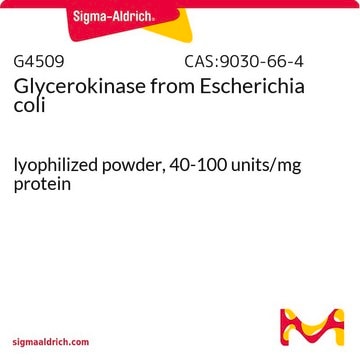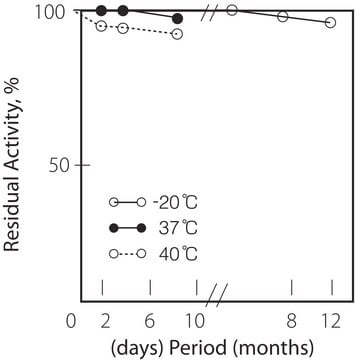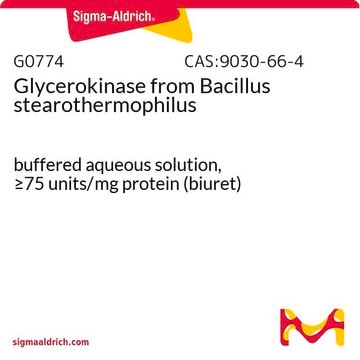G6278
Glycerokinase from Escherichia coli
300-600 units/mL, ammonium sulfate suspension
Synonym(s):
ATP:glycerol 3-phosphotransferase, Glycerol Kinase
Sign Into View Organizational & Contract Pricing
All Photos(1)
About This Item
Recommended Products
biological source
Escherichia coli
form
ammonium sulfate suspension
concentration
300-600 units/mL
storage temp.
2-8°C
Looking for similar products? Visit Product Comparison Guide
General description
Research Area: Cell Signaling
Glycerol kinase (GK) is a member of the FGGY carbohydrate kinase family (ATP: glycerol 3-phosphotransferase), which is responsible for transferring a phosphate group from ATP to glycerol.
Glycerol kinase (GK) is a member of the FGGY carbohydrate kinase family (ATP: glycerol 3-phosphotransferase), which is responsible for transferring a phosphate group from ATP to glycerol.
Application
Glycerol kinase (glpK) was used to study the effects of pain controlling neuropeptides on human fat cell lipolysis.
Glycerol kinase has been used along with adenosine triphosphate (ATP) for the conversion of glycerol to glycerol-3 phosphate (glycerol-3P) in white adipose tissue (WAT) adipocyte samples by label distribution method. It has also been used along with adenosine triphosphate (ATP) in the derivatization of glycerol to sn-glycerol-3 phosphate (glycerol-3P).
Biochem/physiol Actions
Glycerol kinase (GK), the primary enzyme involved in regulating glycerol uptake and its metabolism, was initially identified in E. coli. This enzyme acts as a catalyst in the Mg2+-ATP-dependent phosphorylation of glycerol to produce G3P, a crucial intermediate in various metabolic pathways, including the synthesis of glycerolipids and triglycerides, as well as glycogenesis, glycolysis, and gluconeogenesis.
GK participates in the glycerol 3-phosphate shuttle and, in conjunction with glycerol 3-phosphate dehydrogenase, converts glycerol into dihydroxyacetone phosphate. It plays a pivotal role in plasma glycerol withdrawal, glycerol utilization by different tissues, and in maintaining carbohydrate homeostasis. GK is positioned at the nexus of lipid and carbohydrate metabolism and may play a potential role in type 2 diabetes mellitus (T2DM).
GK participates in the glycerol 3-phosphate shuttle and, in conjunction with glycerol 3-phosphate dehydrogenase, converts glycerol into dihydroxyacetone phosphate. It plays a pivotal role in plasma glycerol withdrawal, glycerol utilization by different tissues, and in maintaining carbohydrate homeostasis. GK is positioned at the nexus of lipid and carbohydrate metabolism and may play a potential role in type 2 diabetes mellitus (T2DM).
Glycerol kinase catalyzes tge MgATP-dependent phosphorylation of glycerol to produce sn-glycerol-3-phosphate and is the rate limiting enzyme in the utilization of glycerol. It is also subject to feedback regulation by fructose-1,6-bisphosphate.
Unit Definition
One unit will convert 1.0 μmole of glycerol and ATP to L-α-glycerophosphate and ADP per min at pH 9.8 at 25 °C in a coupled system with PK/LDH.
Physical form
Suspension in 3.1 M (NH4)2SO4 pH 7.3, with 1% BSA and 2% trehalose
Signal Word
Danger
Hazard Statements
Precautionary Statements
Hazard Classifications
Resp. Sens. 1
Storage Class Code
11 - Combustible Solids
WGK
WGK 3
Flash Point(F)
Not applicable
Flash Point(C)
Not applicable
Personal Protective Equipment
dust mask type N95 (US), Eyeshields, Gloves
Certificates of Analysis (COA)
Search for Certificates of Analysis (COA) by entering the products Lot/Batch Number. Lot and Batch Numbers can be found on a product’s label following the words ‘Lot’ or ‘Batch’.
Already Own This Product?
Find documentation for the products that you have recently purchased in the Document Library.
Customers Also Viewed
Expression and characterisation of human glycerol kinase: the role of solubilising agents and molecular chaperones
Rani RM, et al.
Bioscience Reports, 43(4), BSR20222258-BSR20222258 (2023)
Wendy Escobedo-Hinojosa et al.
MethodsX, 8, 101285-101285 (2021-08-27)
Phosphorous-NMR is scarcely employed to evaluate enzyme kinetics of kinase driven monophosphorylations, despite of being a powerful and reliable tool to undoubtedly detect the actual phosphoryl transfer to the targeted substrate. Another advantage is that an external supplementation source of
Ana Cecilia Ho-Palma et al.
Nutrients, 11(3) (2019-03-03)
Under normoxic conditions, adipocytes in primary culture convert huge amounts of glucose to lactate and glycerol. This "wasting" of glucose may help to diminish hyperglycemia. Given the importance of insulin in the metabolism, we have studied how it affects adipocyte
Floriana Rotondo et al.
Scientific reports, 7(1), 8983-8983 (2017-08-23)
White adipose tissue (WAT) produces large amounts of lactate and glycerol from glucose. We used mature epididymal adipocytes to analyse the relative importance of glycolytic versus lipogenic glycerol in adipocytes devoid of external stimuli. Cells were incubated (24/48 h) with 7/14 mM
Ankit Shah et al.
Metabolites, 12(10) (2022-10-28)
Glycerol can be metabolized to glucose via gluconeogenesis or lactate via glycolysis. It is unknown if glycerol is metabolized similarly in the portal and systemic circulations in humans. Eight metabolically healthy overnight-fasted individuals received equimolar amounts of 13C3-glycerol orally and
Our team of scientists has experience in all areas of research including Life Science, Material Science, Chemical Synthesis, Chromatography, Analytical and many others.
Contact Technical Service







